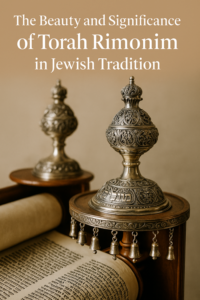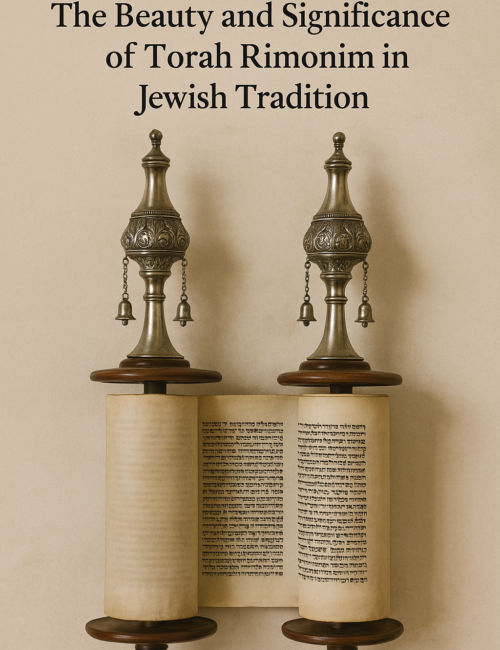In Jewish tradition, few objects embody the majesty and reverence of the Torah scroll like Torah Rimonim—the ornate silver finials that adorn the wooden rollers of the Sefer Torah. Often seen glistening atop the scroll during synagogue services, Torah Rimonim are not merely decorative; they reflect a deep spiritual and historical heritage.
What Are Torah Rimonim?

The word “Rimonim” means “pomegranates” in Hebrew. Traditionally, these finials were shaped like the symbolic fruit, which in Judaism represents abundance, righteousness, and the 613 mitzvot (commandments). Modern Rimonim may retain this symbolism or evolve into intricate, artistic forms crafted from sterling silver, brass, or gold.
Often, they are topped with crowns, bells, and filigree detailing—each bell delicately chiming as the Torah is carried during processions, calling attention to its sanctity.
A Symbol of Glory and Respect
The Sefer Torah is the holiest item in Jewish life, containing the Five Books of Moses handwritten by a skilled scribe. The Rimonim elevate the Torah scroll both physically and spiritually. Just as a king wears a crown, the Torah is adorned in splendor to reflect its divine origin and honored status in the synagogue.
This ornamentation reminds us that Torah study and observance are not casual endeavors—they are noble, sacred pursuits.
Historical Origins and Craftsmanship
Historically, Torah Rimonim emerged in medieval European Jewish communities. Artisans handcrafted these pieces with painstaking precision, often inscribing them with prayers or dedications. Over time, regional styles developed: Eastern European designs were bold and architectural, while Sephardic communities favored graceful, floral embellishments.
Today, Judaica designers combine tradition with modern artistry—resulting in both classic and contemporary styles that appeal to a wide range of communities.
How To
rah Rimonim Are Used Rimonim are primarily attached to the Etz Chaim (Torah rollers), serving both aesthetic and functional purposes. The jingling bells announce the Torah’s presence and inspire awe. They are used:
-
During Shabbat Torah readings
-
On High Holidays and festivals
-
In Torah processions such as Simchat Torah
Their ritual use bridges generations, tying today’s congregations to centuries of Jewish spiritual life.
Choosing a Set for Your Torah
When selecting Rimonim, consider:
-
Material: Sterling silver is traditional, but mixed metals or even wood may be used
-
Weight: Heavier pieces are more durable but must match the scroll’s strength
-
Design: From antique reproductions to minimalist styles, choose based on your community’s aesthetic
At Art Judaica Israel, we carry handcrafted Rimonim that blend heritage with exceptional artistry—each piece is a statement of devotion and beauty.
Final Thoughts
Torah Rimonim are more than silver ornaments—they are enduring symbols of reverence, splendor, and the Jewish people’s eternal connection to Torah. Whether you seek to honor a loved one, celebrate a simcha, or elevate your synagogue’s Torah, these sacred adornments are both meaningful and magnificent.

